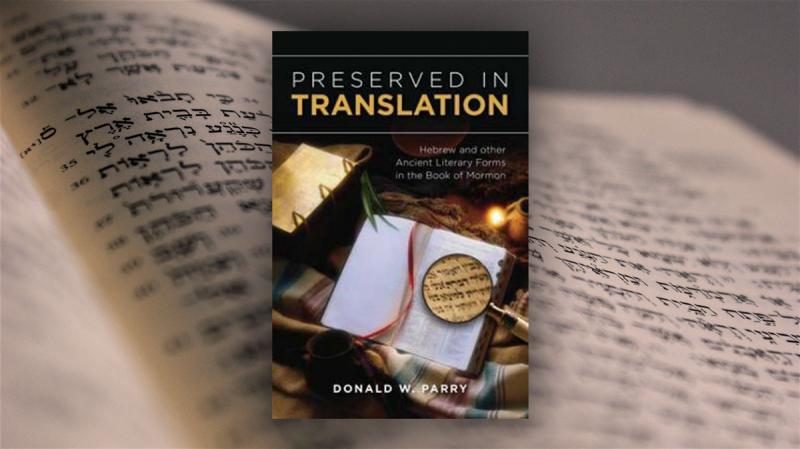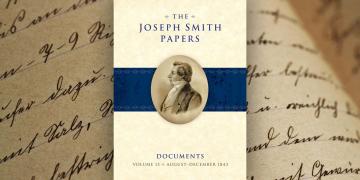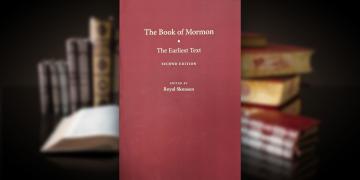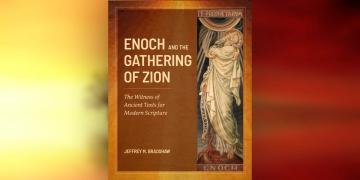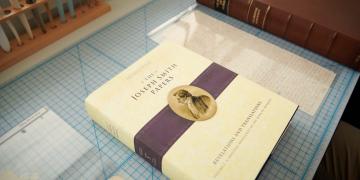You are here
Book of Mormon Central is in the process of migrating to our new Scripture Central website.
We ask for your patience during this transition. Over the coming weeks, all pages of bookofmormoncentral.org will be redirected to their corresponding page on scripturecentral.org, resulting in minimal disruption.
President Russell M. Nelson has said, “Because the Book of Mormon is a translation of a modified Hebrew language, it contains many Hebraisms.”1 A new book by Dr. Donald W. Parry, Preserved in Translation: Hebrew and Other Ancient Literary Forms in the Book of Mormon (Deseret Book and BYU Religious Studies Center) provides numerous examples that support this claim.
For more than 25 years, Dr. Parry has been a professor of Hebrew at BYU, where he has taught Biblical, Qumran, and Mishnaic Hebrew. He has also done extensive academic research on the Hebrew Bible and the Dead Sea Scrolls, which he has presented and published in prestigious academic venues throughout the world. Throughout his career, Parry has drawn on his deep understanding of ancient Hebrew to study the linguistic and literary features of the Book of Mormon.2
In Preserved in Translation, Parry combines his own expertise with that of other scholars who have published studies on the Hebrew-like features of the Book of Mormon,3 producing a thorough survey and introduction to a fascinating topic that both provides evidence for the Book of Mormon’s authenticity, and enhances our understanding of the Book of Mormon central purpose: to testify of Christ.
The book is organized into four parts: (1) parallelism and poetic structures; (2) the art of repetition; (3) prophetic actions and language; (4) other Hebraic patterns. Each of these four sections consists of several short chapters focusing on a specific literary or linguistic feature characteristic of biblical Hebrew and also found in the Book of Mormon. In each, Parry provides ample examples of each feature in both the Bible and the Book of Mormon.
As Parry observed, “The Hebraisms and other ancient literary forms in the Book of Mormon are consistent with its Hebrew background and antiquity.” The cumulative effect of all the Hebrew-like characteristics is impressive. “They are so numerous that they cannot be explained away as coincidence, nor could a modern writer have integrated them so naturally and correctly throughout the entire narrative” (p. xx). Importantly, some of the features Parry highlights cannot be explained as attempts to imitate the King James Bible. “[T]hey are simply too subtle, or even entirely unknown, in the [King James] Bible to have attracted Joseph’s attention” (p. xxvi).
In Parry’s expert opinion: “It is inconceivable that Joseph Smith had technical knowledge of these various archaic Hebraisms, Hebrew-like configurations, literary forms, and other modes of expression, for many of them are subtle in their contexts and relatively inconspicuous in the Old Testament” (p. xx).
Preserved in Translation is available in both hardback and ebook formats, online and in stores through Deseret Book, and as an ebook through Amazon.com.
- 1. See Russell M. Nelson, “A Treasured Testament,” Ensign, July 1993, online at churchofjesuschrist.org. See also, Teachings of Russell M. Nelson (Salt Lake City, UT: Deseret Book, 2018), 42: “The Book of Mormon is rich with Hebraisms—traditions, symbolisms, idioms, and literary forms.”
- 2. See, for example, Donald W. Parry, ed., Poetic Parallelisms: The Complete Text Reformatted (Provo, UT: Neal A. Maxwell Institute for Religious Scholarship, 2007), originally published in 1992. See also Donald W. Parry, “Power through Repetition: The Dynamics of Book of Mormon Parallism,” in Book of Mormon Authorship Revisited: The Evidence for Ancient Origins, ed. Noel B. Reynolds (Provo, UT: FARMS, 1997), 295–309; Donald W. Parry, “Hebraisms and Other Ancient Peculiarities in the Book of Mormon,” in Echoes and Evidences of the Book of Mormon, ed. Donald W. Parry, Daniel C. Peterson, and John W. Welch (Provo, UT: FARMS, 2002), 155–189.
- 3. For previous work on Hebraisms and other ancient literary features in the Book of Mormon by other scholars see Sidney B. Sperry, “Hebrew Idioms in the Book of Mormon,” Journal of Book of Mormon Studies 4, no. 1 (1995): 218–225; Brain D. Stubbs, “Book of Mormon Language,” in Encyclopedia of Mormonism, 4 vols., ed. Daniel H. Ludlow (New York, NY: Macmillan, 1992), 1:179–181; James T. Duke, The Literary Masterpiece Called the Book of Mormon (Springville, UT: Cedar Fort, 2003); Hugh W. Pinnock, Finding Biblical Hebrew and Other Ancient Literary Forms in the Book of Mormon (Provo, UT: FARMS, 1999); John A. Tvedtnes, “Hebraisms in the Book of Mormon: A Preliminary Survey,” BYU Studies 11, no. 1 (1970): 50–60; John A. Tvedtnes, “The Hebrew Background of the Book of Mormon,” in Rediscovering the Book of Mormon, ed. John L. Sorenson and Melvin J. Thorne (Salt Lake City and Provo, UT: Deseret Book and FARMS, 1991), 77–91; John A. Tvedtnes, “Hebraisms in the Book of Mormon,” in Encyclopedia of Hebrew Language and Linguistics, ed. Geoffrey Khan (E. J. Brill, 2013), 2:195–196; David E. Bokovoy and John A. Tvedtnes, Testaments: Links between the Book of Mormon and the Hebrew Bible (Tooele, UT: Heritage Press, 2003); Stephen D. Ricks, “Converging Paths: Language and Cultural Notes on the Ancient Near Eastern Background of the Book of Mormon,” in Echoes and Evidences, 389–419; John Gee, “La Trahison des Clercs: On the Language and Translation of the Book of Mormon,” Review of Books on the Book of Mormon 6, no. 1 (1994): 51–120.
Subscribe
Get the latest updates on Book of Mormon topics and research for free


